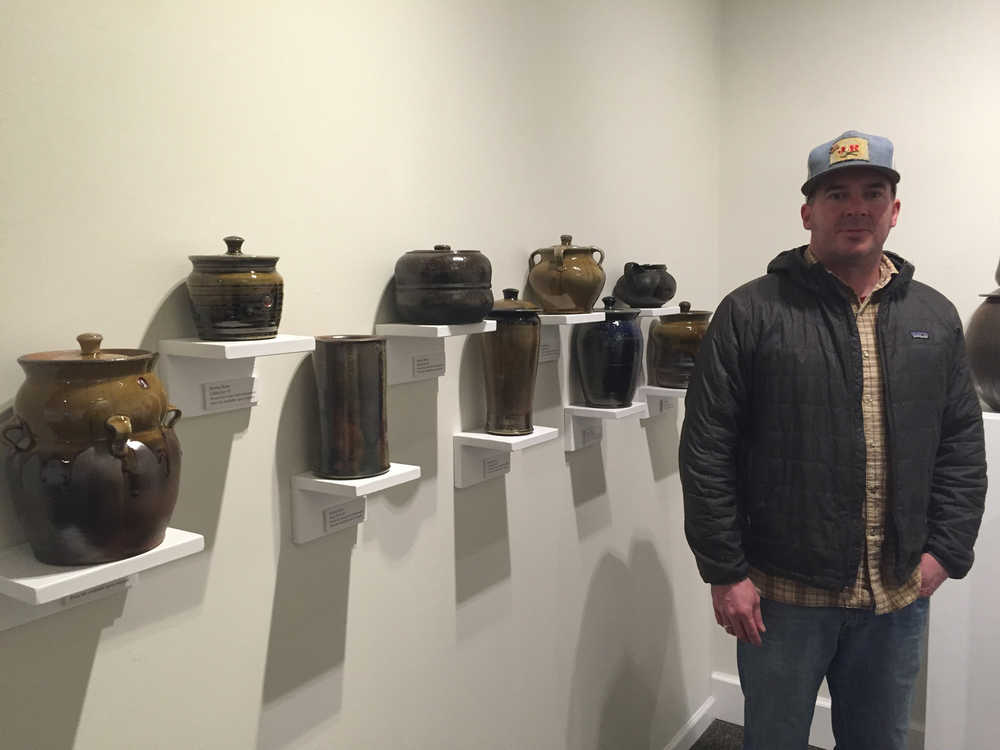University of Alaska Associate Professor of Art and ceramics artist Jeremy Kane’s current show at the Juneau-Douglas City Museum, “Surface,” is a departure from the work he has shown most recently in Juneau, but is in another way more in line with an important aspect of his influence as a ceramics teacher.
The pieces in “Surface” were created in wood-fired kilns, one built with UAA and UAF colleagues and the other with UAS students, highlighting techniques that date back to the third and fourth centuries in Japan. Colors, and variations in surface texture, in the pieces are created by what he put in the kiln when they were being fired.
Some of the pieces are made of porcelain; some of stoneware, or other types of materials. Rock salt he puts in the kiln as the pieces are firing gives some of them a pockmarked appearance; spruce ash, from the wood-fired kiln turns into greenish glaze on other pieces. He also used soda — essentially baking soda — spraying it into the kiln so it affects the pieces fired with it more like vapor, turning them gray.
“Originally I was going to call it (the show) wood, salt and soda,” he said.
For the most part, when he did apply glaze, it was one slightly golden glaze on the whole show, he said.
“When I first started out to do that show, I was thinking about gold nuggets and Alaskana,” he said. “I took it to a different place, but I still wanted that feeling of a gold, luscious surface — a kind of shimmer.”
Those familiar with his usual work know it as retro-style white-ware with sticker-like decals, a kind of Americana art.
“It allows me to make things that look like they might not be handmade,” he said. “It’s just kind of intriguing to make things that are just as high quality, but people want to know, did somebody make this?”
THE BIRTH OF NOSTALGIA
Kane grew up in Southern Ohio, first taking watercolor, drawing, and ceramics classes at the Springfield Museum of Art as a kid.
“I had a pretty cool (ceramics) teacher who was totally giving and allowed us to make things,” he said. “I kept getting inspired by one teacher after the next.”
Before he even went to high school, he’d done ceramics for three years, and when he graduated, he knew he wanted to get back into it.
“At the time I wasn’t thinking professionally. I just knew it was something I wanted to be good at,” he said.
At college at the University of Alaska, Fairbanks, he was studying business — and decided to switch to ceramics, getting a Bachelor of Fine Arts.
It was when he was pursuing a Master of Fine Arts at Ohio University and was looking for a way to reflect his own voice that he evolved his style, which is influenced both by industrial design and a sense of nostalgia.
“I was always a fan of kind of kitsch America, gift shops and things, and getting my hands on small icons with icons of wherever we were,” he said. “You can bring in all kinds of different references.”
He loves old cars and old antiques; he worked at a drug store and cleaned and fixed antiques as a collector, and found when he moved to Alaska, there was a different history. It was returning to Ohio in grad school that helped him discover that aspect of himself, he said.
He’s been an Alaska resident now for 22 years and has taught at UAS for 12.
His music also feeds into his art. Kane plays banjo in the Great Alaska Bluegrass Band.
The banjo, too, people think of as American — but it’s derived from Africa.
“The music that I like the most is derived from other places,” he said. “But the way I play is stereotypically American… based off of rock and roll, and jazz and blues, and things like that.”
TEACHING
Much of what he teaches in class relates not only to ceramics, but the rest of the world.
“I teach (students) about form, and function and how it pertains to everyday tasks – essentially how to be organized, and how to operate their time properly for them to pull off something successful. Ceramics is a timing game, and a drying game — it’s a long process,” he said.
He, UAS students and UAA and UAF colleagues built the two kilns at UAS. One is something people call “a coffin kiln,” or a train kiln, about three feet wide, three feet tall, and 20 feet long.
The other one is smaller, about 16 cubic feet inside. Most of the materials were donated by the community, he said. And then there’s another brick contraption as well — this one specifically for pizzas, which students cook and eat together.
Part of what he tries to create in his classes, and what ceramics lend themselves to, is a communal atmosphere, he said.
Teaching has made him a better potter, he said.
“That’s the beauty of the pottery studio. Students learn from each other,” he said. “It’s not something that you hoard, it’s something that you share…. It’s an all-inclusive team.”
Things go wrong, sometimes; maybe someone knocks over a pot you’ve been working on for hours.
“You’re really teaching a lot of communication skills and life skills,” he said. “It’s a small environment. People have to be able to get along.”
Kane will be giving a free lecture at the museum on Jan. 21 from 7 to 8:30 p.m. The pieces in the show are for sale.
The exhibit is on display through Jan. 30.
• Contact Martin at maryc.martin@capweek.com.

